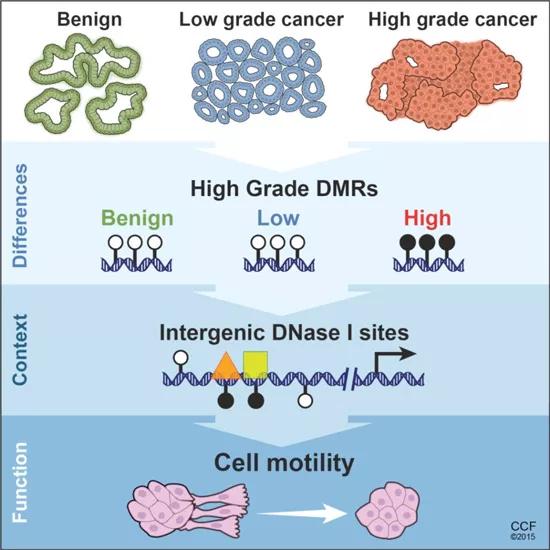Patterns of DNA Methylation May Differentiate Indolent and Aggressive Prostate Cancers


Angela H. Ting, PhD
Advertisement
Cleveland Clinic is a non-profit academic medical center. Advertising on our site helps support our mission. We do not endorse non-Cleveland Clinic products or services. Policy
Prostate cancer continues to be a serious healthcare problem with approximately 220,800 new cases reported in the United States in 2015. The disease course of prostate cancer is heterogeneous and ranges from slow-growing, indolent forms to aggressive, potentially life-threatening forms. Unfortunately, distinguishing between indolent and more aggressive prostate cancers is difficult with currently available markers.
The findings of a study conducted at the Lerner Research Institute of the Cleveland Clinic in collaboration with Eric A. Klein, MD, Chairman of the Glickman Urological and Kidney Institute and Cristina Magi-Galluzzi, MD, PhD, Director of Genitourinary Pathology in the Department of Anatomic Pathology were recently published in the journal Cell Reports. This study used advanced molecular techniques to characterize differences between indolent and more aggressive forms of prostate cancer. According to Angela H. Ting, PhD from the Genomic Medicine Institute at the Lerner Research Institute, this study of DNA methylation patterns not only advances our understanding of the development of prostate cancer, but may eventually lead to diagnostic tools to identify patients with the most aggressive forms of cancer.
Advertisement
Both genetic mutations and epigenetic alterations (i.e., chemical changes to tumor DNA, such as DNA methylation) are believed to be important in carcinogenesis. Dr. Ting explains that DNA methylation is a process that controls whether a gene is expressed, meaning whether the gene is turned off or on. She further indicates that “DNA methylation was selected for study based on the observed low mutation rate in prostate cancers relative to other cancers. The low mutation rate suggests that mechanisms other than genetic mutations are involved, which motivated us to investigate the role of epigenetic changes in the biology of prostate cancers.”
Dr. Ting and her coworkers choose to stratify the prostate tumors studied by histology classified by Gleason scores. The samples were divided into three groups: benign prostatic tissue, low grade (indolent, Gleason score 6) prostate cancer, and high grade (aggressive, Gleason score 8 to 10) prostate cancer. “By stratifying prostate cancer samples using Gleason score derived from radical prostatectomy, our results relate to biological criteria, as opposed to stratifications using recurrence that are influenced by stage of disease at presentation” says Dr. Ting.

Figure 1. The comparison of benign, low-grade, and high-grade prostate tumors showed that high-grade tumors had pervasive focal hypermethylation. Hypermethylated DNA is indicated by black circles and unmethylated DNA is represented by white circles. High-grade DMRs occurred more frequently at intergenic regions and gene bodies than other genomic contexts. In addition, the intergenic DMRs appear highly enriched for DNaseI hypersensitivity sites, which are markers for regulatory DNA regions. Genes near the DMRs regulate cellular activities, such as cellular motility that are purported to play a role in aggressive disease.
Advertisement
Advertisement

First-of-its-kind research investigates the viability of standard screening to reduce the burden of late-stage cancer diagnoses

Global R&D efforts expanding first-line and relapse therapy options for patients

Study demonstrates ability to reduce patients’ reliance on phlebotomies to stabilize hematocrit levels

A case study on the value of access to novel therapies through clinical trials

Findings highlight an association between obesity and an increased incidence of moderate-severe disease

Cleveland Clinic Cancer Institute takes multi-faceted approach to increasing clinical trial access 23456

Key learnings from DESTINY trials

Overall survival in patients treated since 2008 is nearly 20% higher than in earlier patients